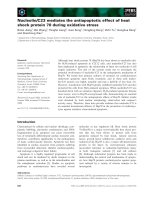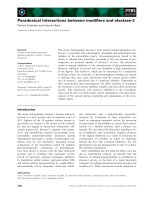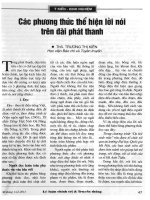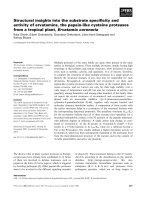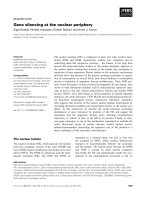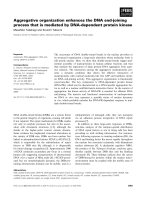Báo cáo khoa hoc:" No connection between the level of exposition to statins in the population and the incidence/ mortality of acute myocardial infarction: An ecological study based on Sweden’s municipalities" pptx
Bạn đang xem bản rút gọn của tài liệu. Xem và tải ngay bản đầy đủ của tài liệu tại đây (255.96 KB, 8 trang )
RESEARCH Open Access
No connection between the level of exposition to
statins in the population and the incidence/
mortality of acute myocardial infarction: An
ecological study based on Sweden’s
municipalities
Staffan Nilsson
1,2*
, Sigvard Mölstad
1,3
, Catarina Karlberg
3
, Jan-Erik Karlsson
4
and Lars-Göran Persson
3
Abstract
Background: Randomised controlled trials have shown an excellent preventive effect of statins on ischemic heart
disease. Our objective was to investigate if a relation can be detected between acute myocardial infarction- (AMI)
mortality or incidence and statin utilisation, for men and women in different age-groups on a population basis.
Results: The utilisation rate of statins increased almost three times for both men and women between 1998 and
2002. During 1998-2000 the incidence of AMI decreased clearly for men but only slightly for women. Mortality
decreased from 1998 to 2002. The change in statin utilisation from 1998 to 2000 showed no correlation to the
change in AMI mortality from 2000 to 2002. Statin utilisation and AMI- incidence or mortality showed no
correlations when adjusting for socio-economic deprivation, antidiabetic drugs and geographic coordinates.
Conclusions: Despite a widespread and increasing utilisation of statins, no correlation to the incidence or mortality
of AMI could be detected. Other factors than increased statin treatment should be analysed especially when
discussing the allocation of public resources.
Keywords: Myocardial infarction, Incidence, Antilipemic agents, Sweden, Population, Ecological study
Background
The premature mortality of cardiovascular disease has
been declining the last decades in Sweden as well as in
many other countries. This is true regarding acute myo-
cardial infarction (AMI) as well, according to nation
wide Swedish statis tics of AMI covering the period from
1987 to present [1]. On a population basis, a previous
study reported a possible negative correlation between
the utilisation of lipid lowering drugs and death in
ischemic heart disease 1989 - 1993 in Swedish munici-
palities [2].
During recent years, the statin utilisation has contin-
ued to increase and reliable AMI incide nce data on a
municipality level has become available [3]. Randomised
controlled trials have shown unequivocal benefits of sta-
tin treatment [4-6]. A detectable relation between statin
utilisation and AMI incidence/mortality on a population
basis should be of great interest for decisions about allo-
cation of preventive resources.
The aim of this study was to evaluate if there exists an
ecological correlation between AMI mortality/incidence
and statin utilisation for men and women in different
age groups in Sweden’s municipalities.
Methods
The study included 289 of 290 Swedish municipalities.
One municipality was excluded due to missing data.
The study includes da ta from1998 to 2002. The Swedish
* Correspondence:
1
Division of Community Medicine, Department of Medicine and Health
Sciences, Faculty of Health Sciences, Linköping University, S-581 83
Linköping, Sweden
Full list of author information is available at the end of the article
Nilsson et al. Journal of Negative Results in BioMedicine 2011, 10:6
/>© 2011 Nilsson et al; licensee BioMed Central Ltd. This is an Open Access article distributed under the terms of the Creative Commons
Attribution License ( which permits unrestr icted use, distribution, and reproduction in
any medium, provided the origina l work is properly cited.
population 40-79 years old in the year 2000 consisted of
1 926 113 men and 1 995 981 women.
The utilisation of statins, and antidiabetic drugs in
1998-2002 among outpatients, was based on the pre-
scriptions served by The Corporation of Pharmacies in
Sweden (Apoteket AB) and expressed in Defined Daily
Doses (DDD) per 1000 Inhabitants and Day (TID) [7].
The DDD for simvastatin was 15 mg, atorvastatin 10 mg
and pravastatin 20 mg. The DDD for antidiabetic drugs
included both insulin and oral drugs.
The number of deaths with AMI (ICD-10 code I21
and I22) as the underlying cause was obtained from The
Causes of Death Register at The Swedish Board of
Health and Welfare. Data on the incide nce, attack rate,
of AMI was obtained from The AMI Statistics at The
Swedish Board of Health and Welfare, and comprised
fatal as well as non-fatal AMIs (ICD-10 code I21 and
I22), as main or secondary diagnosis [3]. The cut off
level of Cardiac troponin T, troponin I or creatine
kinase (CK-MB) for AMI was changed in 2001 and
therefore more AMIs were diagnosed [8]. Routine cor-
onary revascularisation in unstable coronary artery dis-
ease has been shown to reduce mortality and non-fatal
myocardial infarctions after one year [9]. The number of
persons being subjected to corona ry revascularisation i.
e. coronary artery by pass grafting and/or percutan cor-
onary intervention was obtained from the Centre of Epi-
demiology, Swedish Board of Health and Welfare and
the Swedish Coronary Angiography and Angioplasty
Registry (SCAAR). The yearly incidence and mortality of
myocardial infarction and coronary revascularisation
rates were calculated for each of the 289 Swe dish muni-
cipalities for men and women and each of the age
groups 40-49, 50-59, 60-69 and 70-79 years. The popu-
lation sizes for the year 2000 were used.
A socio-economic municipality deprivation index con-
sisting of standardised education level (A), salary (B)
and unemployment (C) wa s calculated for men and
women respectively for the year 2000.
For each municipality,
A = (X1 - mean1)/SD1, where X1 is percentage low
educ ated (9 years) in the particular muni cipality, mean1
is mean percentage of low educated in all municipalities,
SD1 is standard deviation of low educated in all
municipalities,
B = (X2 - mean2)/SD2, where X2 is percentage having
an income within the lowest quartile for Sweden in the
particular municipality, mean2 is m ean percentage of
having an income within the lowest quartile for Sweden
in all municipalities, SD2 is standard deviation for hav-
ing an income within the lowest quartile for Sweden in
all municipalities, and
C = (X3 - mean3)/SD3, where X3 is percentage unem-
ployed, 40-59 years old, mean3 is mean percentage of
unemplo yed 40-59 years old in all municipalities, SD3 is
standard deviation for unemployed 40-59 years old in all
municipalities.
Deprivation index is the sum of A, B and C for the
particular municipality [10]. Data on low education and
low salary was gathered from Statistics Sweden and on
unemployment from The National Labour Market
Board.
Data on the geographic x- and y- coordinates of each
municipality was obtained from The National Land Sur-
vey of Sweden [11,12].
An official grouping of Swedish municipalities into
nine groups according to number of inhabitants and
infrastructure was used, in order to fo rm subgroups of
similar and enough populated municipalities [13]. The
groups were 1: Big city (n = 3). Municipalities with a
population in excess of 200 000 inhabitants, 2: Suburban
municipality (n = 36), 3: Larger town (n = 26). Munici-
palities with 50 000 to 200 000 inhabitants, 4: Medium-
sized town (n = 40). Municipalities with 20 000 to 50
000 inhabitants, 5: Industrial municipality (n = 53), 6:
Rural municipality (n = 30), 7: Sparsely populated muni-
cipality (n = 29). Municipalities with fewer than 20 000
inhabitants, 8: Other larger municipality (n = 31). Muni-
cipalities with 15 000 to 50 000 inhabitants, 9: Other
smaller municipality (n = 42). Municipalities with fewer
than 15 000 inhabitants.
Statistical methods
A simple bivariate Pearson correlation coefficient for
statin utilisation vs. AMI-incidence and AMI-mortality
was calculated for each of the years 1998-2002 and for
respective age-groups and gender. Linear regression ana-
lysis was used. AMI-incidence was used as the depen-
dent variable and utilisation of statins and antidiabetic
drugs, deprivation index, and geographic x- and y-coor-
dinates for each of the 289 municipalities as indepen-
dent variables. Separate analyses were made for each of
the years 1998-2002, and for respective age-groups and
gender . The independent variables were ranked in order
of significant outcomes vs. incidence in a univariate ana-
lyse. According to the ranking, a multivariate statistical
model was constructed including the independent vari-
ables in the following order, deprivation index, antidia-
betic drugs, statin utilisation, x- and y-coordinates. The
multivariate model was used in analysing AMI-incidence
vs. statin utilisation.
In order to minimise the effect of unusual events and
small populations, a multivariate analyses of statin utili-
sation vs. incidence and mortality, was performed in a
group of 26 larger towns, i.e. municipality group 3, with
1857 to 4720 men aged 70-79 years. Considering the
time delay for the preventive effect of statins the change
in statin utilisation from 1998 to 2000 was estimated as
Nilsson et al. Journal of Negative Results in BioMedicine 2011, 10:6
/>Page 2 of 8
the quotient between statin DDDs per TID in 2000 and
in 1998. This quotient was calculated for men aged 70-
79 years in each of 149 municipalities, municipality
groups 3, 4, 5 and 6. Equivalently, the change in mortal-
ity from 2000 to 2002 was calculated in each of those
149 municipalities. A value > 1 implies an increase and
< 1 a decrease in statin utilisation or mortality. Subse-
quently, the quotients representing the change in statin
utilisation and the changeinAMImortalitywere
plotted against each other.
The utilisation of statins, AMI-mortality, AMI-inci-
dence and coronary revascularisation rates are shown as
means (range) in tables. In the text standard deviations
(± SD) also are given.
Results
Statins
The mean utilisation rate of statins for males increased
almost three times, from 46.2 to 131.1 DDD/TID during
the five-year period (Figure 1). The highest increase was
seen in the oldest age-group (Table 1). In 1998, men
aged 60-69 years had the highest use of statins, (mean ±
SD) 75 ± 29 DDD/TID, but in 2002 the highest use was
observed among men 70-79 years old, 218 ± 57 DDD/
TID with a 6-fold variation between municipalities
(range: 71-457 DDD/TID). For women, the mean utilisa-
tion rate of statins increased more than three times,
from 28 to 87 DDD/TID during the five-year period
(Figure 1). The highest increase was seen among the
oldest (Table 2). In 1998, women aged 60-69 y ears had
the highest use of statins 50 ± 20 DDD/TID but in 2002
the highest use was observed among women aged 70-79
years, 165 ± 47 DDD/TID, with a 6-fold variation
between municipalities (range: 56-354 DDD/TID).
Antidiabetic drugs
The mean ± SD utilisation of antidiabetic drugs (DDD/
TID) for the male populations, 40-79 years old,
increased from 67 ± 38 in 1998 to 87 ± 49 in 2002. For
women, the mean utilisation increased from 51 ± 34
1998 to 61 ± 39 in 2002.
Mortality of AMI
In males, mortality decreased from 2.20 to 1.72/1000,
during the five-year period (Figure 1). The largest abso-
lute decrease was among men 70-79 years old and their
mean mortality decreased from 8.74/1000 ± 4.42 in
1998 to 6.73/100 0 ± 4.01 in 2002 (Table 1). In wome n,
mortality decreased from 0.97 to 0.76/1000, during the
five-year period (Figure 1).
0
1
2
3
4
5
6
7
8
9
10
1998 1999 2000 2001 2002
0
20
40
60
80
100
120
140
DDD men
DDD women
Inciden ce men
Inciden ce women
Mortality men
Mortality women
AMI, incidence
and mortality/1000
Statin utilisation
DDD/TID
*
*
Change of cut off level of Cardiac troponin T, troponin I or creatine kinase (CK-MB) for AMI.
Figure 1 Incidence and mortality of acute myocardial infarction (AMI) and statin utilisation in the Swedish population, 40-79 years
old, 1998-2002. Utilisation of statins expressed in Defined Daily Doses per 1000 Inhabitants and Day (DDD/TID).
Nilsson et al. Journal of Negative Results in BioMedicine 2011, 10:6
/>Page 3 of 8
Incidence of AMI
In 2001, the diagnostic criteria for AMI changed. During
the first three years of the study the incidence of AMI
decreased in males from 8.37 to 7.81/1000 and then
again increase d to 8.26 in 2001, follow ed by 8.06 in
2002 (Figure 1). In women, the incidence decreased
slightly during the first three years of the study, from
3.79 to 3.66/1000 and then again increased to 3.86 in
2001 and 3.82 in 2002 (Figure 1).
Coronary revascularisation
Coronary revascularisation rates in males increased dur-
ing the five-year period from 4.53 to 5.96/1000 in the
40-79 year old population. The highest relative and
absolute increase was observed among men 70-79 years
old and their mean revascularisation rate increased from
8.74 ± 4.94 in 1998 to 11.8 ± 5.6 in 2002 (Table 1). In
women, the coronary revascularisation rates increased
during the five-year period from 1.48 to 1.98/1000 in
the 40-79 year old population. The highest relative and
absolute increase was observed among women 70-79
years old and for those the mean revascularisation rate
increased from 3.38 ± 2.60 to 4.60 ± 2.84 in 2002 (Table
2).
Socio-economic deprivation index
The socio-economic deprivation index for males was
(mean ± SD) 0.0 ± 2.01, (range - 6.42- + 6.02) and for
females 0.0 ± 2.29 (range -7.5- + 5.2).
Change in statin utilisation in relation to AMI-mortality
change
There was no connect ion between the quotient of statin
utilisation in 2000 and 1998 and the quotient of AMI
mortality in 2002 and 2000 among the male populations,
70-79 years old in 149 municipalities (Figure 2).
Bivariate correlation and multivariate analysis
Statin utilisation and AMI -incidence had a statistically
significant negative bivariate and multivariate correlation
for 70-79 years old men in the three years 1998 to 2000
(Table 3). In 1998 the correlation coefficient (r) was
Table 1 Utilisation of statins, acute myocardial infarction (AMI)-mortality, AMI-incidence and coronary
revascularisation rates in Sweden’s 289 municipalities’ male populations, 1998-2002.
Utilisation of statins DDD/TID
1
Age/years 1998 1999 2000 2001 2002
40-49 14.0 (2.28-47.5) 18.2 (2.29-49.5) 23.7 (2.46-59.1) 28.0 (1.63-72.0) 32.0 (4.26-75.7)
50-59 43.4 (10.3-114) 58.2 (12.5-182) 78.1 (20.2-184) 95.0 (34.7-222) 111 (42.5-267)
60-69 75.0 (21.1-196) 103 (34.6-267) 139 (43.1-363) 171 (56.8-391) 202 (93.2-400)
70-79 62.1 (5.82-167) 92.1 (14.9-221) 133 (34.2-319) 174 (47.0-384) 218 (71.3-457)
AMI-mortality/1000
1
Age/years 1998 1999 2000 2001 2002
40-49 0.25(0-3.57) 0.24 (0-4.00) 0.26 (0-6.17) 0.21 (0-2.78) 0.15 (0-3.07)
50-59 0.82 (0-6.05) 0.72 (0-4.67) 0.91 (0-7.50) 0.74 (0-7.25) 0.74 (0-7.14)
60-69 2.94 (0-11.3) 2.65 (0-12.9) 2.58 (0-9.76) 2.36 (0-10.9) 2.40 (0-9.17)
70-79 8.74 (0-24.5) 8.61 (0-24.7) 7.81 (0-25.0) 6.80 (0-23.6) 6.73 (0-24.7)
AMI-incidence/1000
1
Age/years 1998 1999 2000 2001 2002
40-49 1.60 (0-9.67) 1.49 (0-6.22) 1.37 (0-6.17) 1.39 (0-6.02) 1.33 (0-7.75)
50-59 5.00 (0-20.3) 4.53 (0-15.0) 4.63 (0-15.8) 4.93 (0-21.7) 4.63 (0-14.0)
60-69 11.6 (0-27.5) 11.2 (1.3-31.9) 10.7 (0-27.8) 11.1 (0-28.7) 11.6 (0-27.9)
70-79 26.2 (0-61.3) 26.1 (3.0-61.7) 25.6 (4.9-53.7) 25.9 (0-61.4) 25.2 (4.1-54.3)
Coronary-revascularisation/1000
1
Age/years 1998 1999 2000 2001 2002
40-49 1.26 (0-8.00) 1.32 (0-6.17) 1.34 (0-12.9) 1.34 (0-6.30) 1.45 (0-8.10)
50-59 4.00 (0-14.7) 4.27 (0-27.0) 4.41 (0-15.5) 5.14 (0-20.4) 5.21 (0-14.5)
60-69 7.55 (0-19.6) 8.02 (0-24.2) 8.35 (0-20.67) 9.25 (0-32.5) 10.0 (0-26.4)
70-79 8.74 (0-28.5) 9.22 (0-32.5) 9.65 (0-31.9) 10.9 (0-35.6) 11.8 (0-32.5)
Utilisation of statins expressed as Defined Daily Doses per 1000 Inhabitants and Day (DDD/TID).
1
Mean (range)
Nilsson et al. Journal of Negative Results in BioMedicine 2011, 10:6
/>Page 4 of 8
-0.168 (p = 0.004), in 1999 -0.172 (p = 0.003) and in
2000 -0.170 (p = 0.004). The regression coefficient (b)
in 1998 was -0.042 (p = 0.043), in 1999 -0.040 (p =
0.014) and in 2000 - 0.026 (p = 0.021). Adjustment was
made for socio-economic deprivation, antidiabetic drugs,
x- and y-coordinates. For women 70-79 years old, there
was a stat istically significant negative bivariate correla-
tion 1998-1999. In 1998 r was -0.137 (p = 0.020) and in
1999 -0.154 (p = 0.009). In the multivariate analyses of
these years there was a statistical significance only in
1999, b -0.032 (p = 0.011) (Table 3). In the bivariate
testing, statin utilisation and AMI-mortality had fewer
statistically significan t correlations than statin utilisation
and AMI-incidence. Multivariate analysis of statin utili-
sation vs. incidence and vs. mortality of AMI for men
70-79 years old, in 26 larger towns with 50 -200 000
inhabitants showed no statistically significant results.
Discussion
From 1998 to 2002 statin utilisation tripled in the
Swedish population 40-79 years old. Bivariate and
multivariate analysis for different age-groups and gen-
der showed no correlation for statin utilisation vs.
AMI incidence or mortality. These ecological observa-
tions do not support that statin therapy is a major
contributory cause to the decreasing incidence and
mortality in AMI.
Results from an ecological study are best not being
interpreted at the individual level, thus avoiding the eco-
logical fallacy [2,14]. However, the results can be used as
a basis for discussion and for the generation of new
alternative hypotheses. The used data collected from dif-
ferent registries were judged to be of sufficient quality
[15]. However, we do not know how much of the statins
dispensed by the pharmacies in this study that were
actually consumed, but adherence with statin therapy is
shown to be rather low [16]. The change in diagnostic
cut-off values for AMI was an unforeseen draw back,
limiting the comparisons with clinical trials and earlier
ecological studies. To overcome variations in AMI mor-
bidity and statin utilisation linked to socio-economic
factors, we adjusted with a socio-economic deprivation
Table 2 Utilisation of statins, acute myocardial infarction (AMI)-mortality, AMI-incidence and coronary
revascularisation rates in Sweden’s 289 municipalities’ female populations, 1998-2002.
Utilisation of statins DDD/TID
1
Age/years 1998 1999 2000 2001 2002
40-49 4.98 (0.27-18.7) 6.68 (0.2-32.7) 9.22 (0.13-41.3) 11.2 (0.82-46.4) 13.1 (0.88-38.2)
50-59 19.6 (2.14-59.9) 28.2 (6.45-86.8) 40.3 (11.0-135) 50.6 (15.6-207) 61.5 (20.8-221)
60-69 49.8 (7.52-120) 69.8 (10.7-162) 96.2 (18.1-206) 119 (40.7-251) 141 (45.3-288)
70-79 45.7 (3.05-128) 67.1 (17.4-178) 97.8 (30.9-250) 131 (40.3-315) 165 (56.2-354)
AMI-Mortality/1000
1
Age/years 1998 1999 2000 2001 2002
40-49 0.06 (0-2.56) 0.06 (0-2.36) 0.07 (0-2.60) 0.05 (0-2.56) 0.04 (0-3.36)
50-59 0.15 (0-2.02) 0.17 (0-4.59) 0.22 (0-2.69) 0.21 (0-4.07) 0.19 (0-3.02)
60-69 0.86 (0-8.06) 1.00 (0-7.16) 0.91 (0-7.16) 0.87 (0-7.17 0.75 (0-8.33)
70-79 3.96 (0-15.3) 3.92 (0-17.2) 3.46 (0-13.9) 2.98 (0-13.7) 3.00 (0-20.0)
AMI-Incidence/1000
1
Age/years 1998 1999 2000 2001 2002
40-49 0.45 (0-4.75) 0.46 (0-4.14) 0.41 (0-4.72) 0.46 (0-7.47) 0.42 (0-5.35)
50-59 1.28 (0-10.9) 1.48 (0-5.74) 1.46 (0-8.45) 1.57 (0-11.1) 1.53 (0-6.37)
60-69 4.28 (0-15.4) 4.36 (0-18.0) 4.19 (0-15.7) 4.51 (0-31.7) 4.49 (0-14.9)
70-79 13.1 (0-33.5) 12.8 (0-33.4) 12.6 (0-47.4) 13.0 (0-31.2) 12.8 (0-35.2)
Coronary-Revascularisation/1000
1
Age/years 1998 1999 2000 2001 2002
40-49 0.32 (0-3.36) 0.28 (0-4.14) 0.32 (0-2.14) 0.34 (0-3.30) 0.42 (0-5.35)
50-59 0.95 (0-5.88) 1.13 (0-6.56) 1.24 (0-8.45) 1.28 (0-7.85) 1.25 (0-8.06)
60-69 2.49 (0-11.9) 2.42 (0-15.7) 2.66 (0-12.2) 3.08 (0-13.6) 3.18 (0-11.3)
70-79 3.28 (0-17.2) 3.24 (0-13.1) 3.87 (0-19.1) 3.95 (0-31.9) 4.60 (0-17.4)
Utilisation of statins expressed as Defined Daily Doses per 1000 Inhabitants and Day (DDD/TID).
1
Mean (range)
Nilsson et al. Journal of Negative Results in BioMedicine 2011, 10:6
/>Page 5 of 8
index. Low education and low household income have
been shown to be of equal importance for cardiovascu-
lar risk for men and women [17,18]. Aiming to adjust
for a possible east-west and north-south geographic var-
iation in AMI morbidity in Sweden, adjustment was
made for geographical coordinates in each municipality
[11,12]. There was a clear increase in coron ary revascu-
laris ation rates, particularl y among men and women 70-
79 years old. However, since the indication for revas cu-
larisation often is an AMI, this variable was not included
in the multivariate model. Data on life-style factors such
as smoking, dietary habits or leisure time physical activ-
ities were not available on a municipality level. However,
changes in life-style factors may be of much higher sig-
nificance for changes in the incidence of AMI or mor-
tality rates than statins [19,20]. Smoking has gradually
decreasedinSwedenduringthelast30yearsbothin
women and particularly in men and the number of daily
smokers in 2005 was 13 and 17 percent for men and
women, respectively. To some extent, smoking habits
could be assumed to be included in the socio economic
deprivation index, since people with low education more
often are smokers.
Merlo found a significant reduction of the relative risk
of death from ischemic heart disease correlating to a ris-
ing utilisation of statins in Swedish municipalities ana-
lysed by quartiles 1989-1993 [2]. In our study, in
addition to A MI-mortali ty, we analysed AMI incidence
comprisedofbothlethalandnotlethalAMIs,thus
using a measure with severe as well as less severe AMIs.
We analysed respective age-groups and gender, in con-
trast to Merlo et al, to investigate a possible c orrelation
between statin utilisation and AMI mortality or AMI-
incidence among the oldest with the highest morb idity
and utilisation of statins. Our hypothesis was that a pos-
sible relationship between statin use and decrease in
AMI mortality/incidence would be more likely to be
detected in older age groups.
According to randomised controlled trials in both
primary and secondary prevention the effects of statins
become obvious within 1-2 years after randomisation
[5,6]. Considering this time delay we investigated the
potential connection between change in statin utilisa-
tion and change in mortality two years later among 70
to 79 year old men. One could argue that a connection
between a high increase in statin utilisation and a
Change in statin utilisation from 1998 to 2000
Change in AMI mortality from 2000 to 2002
Figure 2 Change in statin utilisation from 1998 to 2000 plotted against change in acute myocardial infarction (AMI) mortality form
2000 to 2002. A value > 1 indicates an increase and <1 a decrease. Each dot represents all men, 70-79 years old, in municipality groups 3-6.
Municipality groups 3-6 comprises of municipalities enough populated and with a fairly stable infrastructure.
Nilsson et al. Journal of Negative Results in BioMedicine 2011, 10:6
/>Page 6 of 8
decrease in AMI-mortality on a municipality basis
could be more easily detected after a longer period
than two years. However, decreased compliance to sta-
tin treatment and change in other riskfactors e.g.
smoking, obesity or physical exercise would make the
results invalid. We don’t know how much of the sta-
tins that were used for primary or secondary preven-
tion. Increased primary prevention use, potentially
results in decreased AMI mortality. Increased second-
ary prevention use may also result in decreased AMI
mortality. However, there is a matter of reversed cau-
sation i.e. the more AMIs the more statins used. We
addressed this issue by analysing the potential connec-
tion between the change in statin utilisation and again
change in AMI mortality two years later. The hypoth-
esis was that a big increase in statin utilisation could
be related to a decrease in AMI-mortality two years
later, irrespective of the indication for statin treatment.
However, we found no c onnection between the change
in statin utilisation and again change in AMI mortality
two years later (Figure 2).
In this st udy, no correlations of importance were
found between statin utilisation and AMI incidence/
mortality (Table 3). It must be emphasised that some of
the correlation coefficients in table 3 are significantly
different from zero, but the value of the correlation
coefficients are very low, so the grade of linearity is
non-existent. Significance is only due to a large number
of observations. The unequivocal benefits shown in ran-
domised controlled trials are in contrast to the results in
this study [4-6]. N umber needed to treat (NNT) is the
inverted absolute risk reduction. Using data from a pri-
mary preventiv e randomised controlled trial in men [6],
would give a NNT/year of 235 (95% CI, 152-490) for
non-fatal AMI or death from coronary heart disease.
The observed yearly, average increase in male statin use
in our study, 21.2 DDD/TID, corresponds to 10.6 study
doses of p ravastatin and a calculated possible decrease
in AMI-incidence of 9/100 000 male s during 1998-2000,
attributable to statins. In the present study we observed
a decrease in AMI incidence of 56/100 000 men, 40-79
year old, between 1998-2000. Hence, a use of statins
according to this primary preventive study would theo-
retically be able to explain 9/56, 16 percent of the
observed decrease of AMI-incidence 1998-2000. In a
secondary preventive randomised controlled trial [5], the
NNT for preventing a mortal AMI/year can be calcu-
lated to be 362 (95% CI 227-902). Applying these study
data on the present study, statin use might explain 12/
48, 25 percent of the observed decrease of male AMI-
mortality 1998-2002. Making the same type of theoreti-
calcalculationonAMI-incidencedata[5],theuseof
statins should be able to explain 32/56, 57 percent of
the observed decrease of male AMI-incidence 1998-
2000.
Statin studies are often not planned to reveal possi ble
differences in treatment effects between women and
men. No primary preven tive reduction of cardiovascular
mortality or incidence of non-fatal AMI has been shown
in women, but possibly of coronary heart disease events
[21]. Secondary preventive effects in women, are less
well documented tha n in men [22]. An interestin g find-
ing is that women appeared to be prescribed more sta-
tins than men in relation to their risk for AMI , using
incidence and mortality as a proxy measure of risk (Fig-
ure 1).
Conclusions
Though a widespread and increasing utili sation of sta-
tins, no correlation with AMI incidence/mortality in a
general Swedish population, independent of age and
gender, could be detected in this explorative study. The
benefits shown in clinical trials could not be recognized
Table 3 Correlation coefficients (r) and regression
coefficients (b) for statin utilisation vs. acute myocardial
infarction (AMI)-incidence
Statin utilisation vs. AMI-incidence
Male Female
Age Year r b
1
r b
1
40-49 1998 0.051 0.005 0.061 0.009
1999 0.303*** 0.046*** 0.165** 0.024*
2000 0.131* 0.011 0.115 0.011
2001 0.126* 0.017* 0.040 -0.005
2002 0.037 0.001 -0.071 -0.008
50-59 1998 0.141* 0.007 0.086 0.004
1999 0.287*** 0.028*** 0.017 -0.017*
2000 0.141* 0.011 0.064 -0.002
2001 -0.047 -0.016** 0.115 0.004
2002 -0.000 -0.006 0.148* 0.003
60-69 1998 0.052 0.010 0.097 -0.0005
1999 0.026 0.003 0.146* 0.002
2000 -0.032 -0.001 0.146* 0.010
2001 0.081 0.009 -0.017 -0.006
2002 -0.042 -0.004 0.051 -0.004
70-79 1998 -0.168** -0.042* -0.137* -0.031
1999 -0.172** -0.040* -0.154** -0.032*
2000 -0.170** -0.026* -0.042 -0.006
2001 -0.024 0.005 -0.036 -0.007
2002 -0.082 -0.009 -0.062 -0.004
1
b for statin utilisation in repeated multivariate linear regression analyses
with AMI-incidence as dependent variable and deprivation index, utilisation of
antidiabetic drugs, statin utilisation and x- and y-coordinates as independent
variables
*P < 0.05, **P < 0.01, ***P < 0.001
Nilsson et al. Journal of Negative Results in BioMedicine 2011, 10:6
/>Page 7 of 8
despite that a high fraction of the population studied
used statins. It is obvious that factors other than
increased statin treat ment should be analysed, especially
when discussing the allocation of public resources.
Ethical approval
The study was approved by the ethics committee of the
Faculty of Health Sciences of Linköping University.
Funding
This study was supported by grants from Health
Research Council in the South-east of Sweden (FORSS)
[grant number 1380] and the County Council of Öster-
götland. The study was designed, conducted, analysed,
and interpreted independently of all funding sources.
Abbreviations
AMI, Acute myocardial infarction; β, Regression coefficient; DDD, Defined
daily doses; DDD/TID, Defined daily doses per 1000 inhabitants and day; ICD
10, International Classification of Diseases and Related Health Problems 10
th
version; NNT, Number needed to treat; r, Correlation coefficient.
Author details
1
Division of Community Medicine, Department of Medicine and Health
Sciences, Faculty of Health Sciences, Linköping University, S-581 83
Linköping, Sweden.
2
Vikbolandet Health Care Centre, Department of Primary
Health Care, County Council of Östergötland, Norrköping, Sweden.
3
Unit of
R&D in Primary Care, S-551 85 Jönköping, Sweden.
4
Division of Cardiology,
Department of Internal Medicine, Ryhov County Hospital, S-551 85
Jönköping, Sweden.
Authors’ contributions
SN carried out the study, participated in the design of the study and wrote
the manuscript. SM led the study design and writing. CK did the statistical
analyses. JEK and LGP contributed to study design and drafting. All authors
read and approved the final manuscript.
Competing interests
JEK has been reimburs ed by AstraZeneca, MSD and Pfizer for lectures about
statin treatment.
Received: 4 September 2010 Accepted: 24 May 2011
Published: 24 May 2011
References
1. Myocardial infarctions in Sweden 1987-2008. The Swedish Board of
Health and Welfare. [ />11-17].
2. Merlo J, Lindberg G, Lindblad U, Lindgren A, Rastam L, Melander A:
Utilization of cardiovascular drugs (blood pressure lowering drugs, lipid
lowering drugs and nitrates) and mortality from ischaemic heart disease
and stroke. An ecological analysis based on Sweden’s municipalities. Eur
J Clin Pharmacol 1999, 55:69-76.
3. The AMI Statistics at The Swedish Board of Health and Welfare, Centre
of Epidemiology. [].
4. Baigent C, Keech A, Kearney PM, Blackwell L, Buck G, Pollicino C, Kirby A,
Sourjina T, Peto R, Collins R, Simes R: Efficacy and safety of cholesterol-
lowering treatment: prospective meta-analysis of data from 90,056
participants in 14 randomised trials of statins. Lancet 2005,
366:1267-1278.
5. Pedersen: Randomised trial of cholesterol lowering in 4444 patients with
coronary heart disease: the Scandinavian Simvastatin Survival Study (4S).
Lancet 1994, 344:1383-1389.
6. Shepherd J, Cobbe SM, Ford I, Isles CG, Lorimer AR, MacFarlane PW,
McKillop JH, Packard CJ: Prevention of coronary heart disease with
pravastatin in men with hypercholesterolemia. West of Scotland
Coronary Prevention Study Group. N Engl J Med 1995, 333:1301-1307.
7. WHO Colloborating Centre for Drug Statistics Methodology. [http://www.
whocc.no].
8. Alpert JS, Thygesen K, Antman E, Bassand JP: Myocardial infarction
redefined–a consensus document of The Joint European Society of
Cardiology/American College of Cardiology Committee for the
redefinition of myocardial infarction. J Am Coll Cardiol 2000, 36:959-969.
9. Wallentin L, Lagerqvist B, Husted S, Kontny F, Stahle E, Swahn E: Outcome
at 1 year after an invasive compared with a non-invasive strategy in
unstable coronary-artery disease: the FRISC II invasive randomised trial.
FRISC II Investigators. Fast Revascularisation during Instability in
Coronary artery disease. Lancet 2000, 356:9-16.
10. Carstairs V: Deprivation indices: their interpretation and use in relation to
health. J Epidemiol Community Health 1995, 49(Suppl 2):S3-8.
11. Nerbrand C, Olsson L, Svardsudd K, Kullman S, Tibblin G: Are regional
variations in ischaemic heart disease related to differences in coronary
risk factors? The project ‘myocardial infarction in mid-Sweden’. Eur Heart
J 1991, 12:309-314.
12. Gyllerup S, Lanke J, Lindholm LH, Schersten B: High coronary mortality in
cold regions of Sweden. J Intern Med 1991, 230:479-485.
13. Sveriges Kommuner och Landsting. [ />Aldre_indelning_1999-2004.aspx].
14. Piantadosi S, Byar DP, Green SB: The ecological fallacy. Am J Epidemiol
1988,
127:893-904.
15. Rosen M, Alfredsson L, Hammar N, Kahan T, Spetz CL, Ysberg AS: Attack
rate, mortality and case fatality for acute myocardial infarction in
Sweden during 1987-95. Results from the national AMI register in
Sweden. J Intern Med 2000, 248:159-164.
16. Jackevicius CA, Mamdani M, Tu JV: Adherence with statin therapy in
elderly patients with and without acute coronary syndromes. Jama 2002,
288:462-467.
17. Andersen I, Osler M, Petersen L, Gronbaek M, Prescott E: Income and risk
of ischaemic heart disease in men and women in a Nordic welfare
country. Int J Epidemiol 2003, 32:367-374.
18. Strand BH, Tverdal A: Can cardiovascular risk factors and lifestyle explain
the educational inequalities in mortality from ischaemic heart disease
and from other heart diseases? 26 year follow up of 50,000 Norwegian
men and women. J Epidemiol Community Health 2004, 58:705-709.
19. Unal B, Critchley JA, Capewell S: Modelling the decline in coronary heart
disease deaths in England and Wales, 1981-2000: comparing
contributions from primary prevention and secondary prevention. Bmj
2005, 331:614.
20. Doll R, Peto R, Boreham J, Sutherland I: Mortality in relation to smoking:
50 years’ observations on male British doctors. Bmj 2004, 328:1519.
21. Mora S, Glynn RJ, Hsia J, MacFadyen JG, Genest J, Ridker PM: Statins for the
primary prevention of cardiovascular events in women with elevated
high-sensitivity C-reactive protein or dyslipidemia: results from the
Justification for the Use of Statins in Prevention: An Intervention Trial
Evaluating Rosuvastatin (JUPITER) and meta-analysis of women from
primary prevention trials. Circulation 121:1069-1077.
22. Walsh JM, Pignone M: Drug treatment of hyperlipidemia in women. Jama
2004, 291:2243-2252.
doi:10.1186/1477-5751-10-6
Cite this article as: Nilsson et al.: No connection between the level of
exposition to statins in the population and the incidence/mortality of
acute myocardial infarction: An ecological study based on Sweden’s
municipalities. Journal of Negative Results in BioMedicine 2011 10:6.
Nilsson et al. Journal of Negative Results in BioMedicine 2011, 10:6
/>Page 8 of 8

